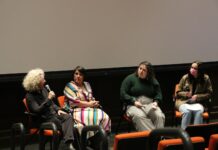Author: Morgan Flake, Contributor
As an Oxy student, you’ve probably visited a few neighborhoods outside the Oxy bubble. Definitely Pasadena and Highland Park, probably Santa Monica and Hollywood, maybe Silverlake and Echo Park. But have you made it to Watts? You’ve probably also seen a couple of art museums like the Getty or LACMA, maybe you’ve toured the galleries in the Downtown Art Walk or the Northeast L.A. Art Walk. But have you seen any art centers of the beaten path? If not, then add the Watts Towers and Arts Center to your list, and go now if you don’t want to miss their current Pacific Standard Time exhibit, “Civic Virtue: The Impact of the Los Angeles Municipal Art Gallery and the Watts Towers Arts Center.”
The title is apt. Like the other Pacific Standard Time exhibits throughout Los Angeles this year, it features multicultural California artists. However, this exhibit goes further, hodting a social justice and cultural history element that highlights the relevance of its location. If you make it to Watts once during your tenure in Los Angeles, make it now, because the information and art in this exhibit will provide a context and shape a deeper understanding of Watts.
The arts exhibit is intrinsically linked to its location beside the Watts Towers in the heart of Watts. These colorful, Gaudi-esque towers stand out from their surroundings as much as the Soviet baby-sculpture-covered Žižkov TV Towers in Prague. Sabato “Simon” Rodia, an Italian immigrant and construction worker, began building what became the Watts Towers in 1921 out of found materials: thousands of shells and pieces of glass, pottery, and china that he used to form a bright and eclectic mosaic. The Towers are more than towers, really; over the course of 35 years, Rodia built a little castle on his triangle of property, dubbing it “Nuestro Pueblo,” or Our Town.
It certainly does not seem representative of the rest of the town of Watts, but it came to be a center for community and a sanctuary for the arts. When Rodia finished the massive sculpture, he left town, never to be seen again. The property, abandoned to a truant neighbor, became the target of a demolition project by the City. The Towers were only saved through the advocacy of an actor and filmmaker, who formed a committee of supporters. By 1961, they became the site of art classes for youth.
The Civic Virtue exhibit’s photographs by Sister Mary Corita Kent document the fight to save the Watts Towers. Surreal shots of protesters in costume marching through the Towers seem like a whimsical art project, but in fact reveal the creative nature of organizing efforts around the Towers. A silkscreen by Kent combines poetry emblazoned over a sheet of red beside a print of the Los Angeles Times from Saturday, August 14, 1965. The headline reads: “Eight Men Slain: Guard Moves In.”
Of course Watts is best known for the riots that exploded that year. The riots broke out after the violent arrest of a Black man for allegedly driving while intoxicated; they led to 34 deaths and over 3,000 arrests. Amidst the chaos under martial law, the Watts Towers and Arts Center remained untouched, and youth gathered in this peaceful haven. Artists Judson Powell and Noah Purifoy later collected debris from the riots. Along with other artists, they created Sixty-Six Signs of Neon, an assemblage of the wreckage of the riots. Photographs of Sixty-Six Signs of Neon feature in the Civic Virtue exhibit as well.
Civic Virtue’s multimedia collection includes the Andy Warhol film Tarzan and Jane Regained… Sort Of, which features actors climbing around in the Watts towers and a rare cameo of Warhol himself. Slideshows and videos uncover the lengthy history of organizing and arts based at the Watts Towers and Arts Center. Some of former Center director Noah Purifoy’s art, such as a large wooden sculpture, hang prominently from the walls, revealing the high art made within and inspired by the Watts Towers and Arts Center.
Today the Center continues to provide art classes for youth, including animation, photography, piano, and an arts summer camp. The site is also home to an annual jazz festival and a drum festival; the likes of the late Etta James have performed there over the years. The Towers are now recognized as a national historical site. The Watts Towers and Arts Center combine art, activism, and history, and the Civic Virtue exhibit shares the story.
If you visit, consider taking the metro. The blue line’s 103rd Street station is directly across the street from the towers, making this an accessible destination without a car. And if you come all the way to Watts, stay a while. Explore the neighborhood around the Towers to get a better sense of this historic location. If you get hungry, check out the Watts Coffee House for their famous waffles and enormous soul food menu and dine surrounded by photos and records of the best Black American musicians of the last century, from Nina Simone to Tupac Shakur.
And when you leave the Arts Center, be sure to sign their petition to the mayor and councilmember Janice Hahn calling for continued funding of their arts programs. Once you visit the Watts Towers and Arts Center, I am sure you will agree that this is an asset to the community worth investing in and cherishing.
This article has been archived, for more requests please contact us via the support system.
![]()






































